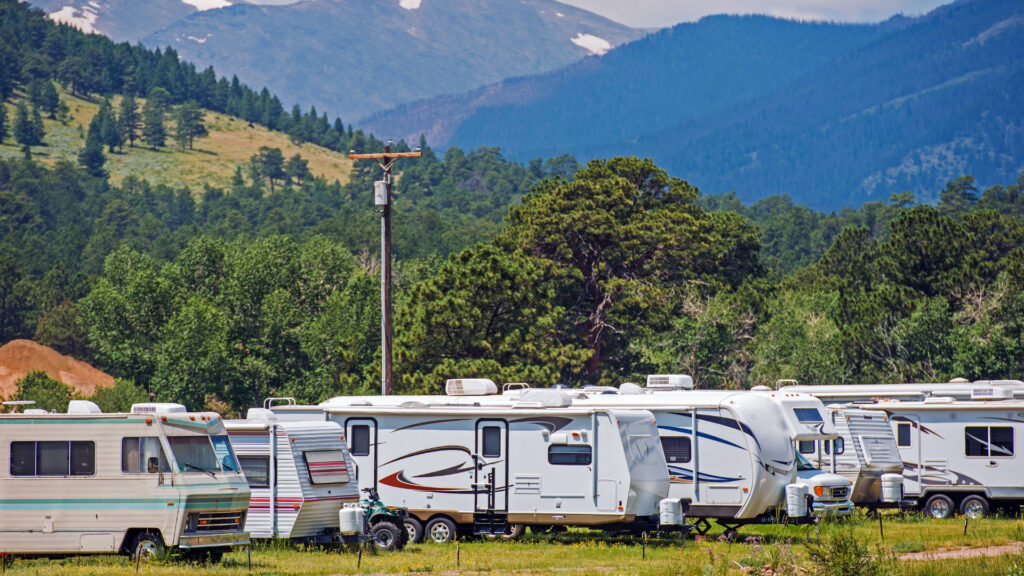Table of Contents Show
Money is one of those uncomfortable topics that no one wants to discuss. However, we recently saw a group of RVers who were vulnerable and transparent enough to share the details of their RV life budgets.
With so many people jumping into the lifestyle, we need honesty and transparency now more than ever. It’s helping people decide if it’s a lifestyle they can afford to enjoy.
Today, we’ll look at seven budgets from various situations. Hopefully, this can give you a better idea of what to expect financially regarding a full-time RV life budget. Let’s get started!
Can You Save Money Living in an RV?
It is possible to save money while living in an RV. However, it’s also possible to spend substantially more living in an RV than in a residential house.
Whether or not you’ll save money by living in an RV depends on your travel style. The cheapest way to live in an RV is to be stationary or to move your RV as little as possible.
Moving your RV from one location to the next can cost a ton of money. In addition, many campgrounds and RV parks offer steep discounts for those booking long-term stays, typically a month or more.
If you want to save money, you’ll want to take advantage of these options. On the other hand, it’s possible to enjoy a very luxurious life while RVing.
You can find RVs that cost six and seven figures and then park them in RV parks that cost over $100 per night. The park and your expensive RV may have more luxury amenities than you thought were possible in an RV, and you’ll pay a pretty penny for them.
Is Full-Time RV Life Expensive?
In general, RV life is typically more expensive than most people anticipate. RV life is full of many costs that you simply can’t control.
Campsite reservations have skyrocketed in recent years, and fuel costs are astronomical. Many full-time RVers can no longer afford to move every week or two as they did in the past.
Many travelers invest in self-sufficiency to help them avoid paying expensive camping fees. This typically means getting solar panels, lithium batteries, and inverters to provide power when camping outside an established campground.
However, you can easily spend over $10,000 on the equipment to be self-sufficient.
One of the best things about RV life is that there’s no right or wrong way to do it. As a result, costs can vary considerably based on the situation, personal preferences, and other factors.
So let’s look at seven budgets from seven full-time RV life situations to help you understand the real costs of full-time RVing. Let’s dive in!
1. Full-Time Family – $5,000
One user, Ross Godwin, is a great example of some of the many full-time families that hit the road. With two adults and two kids, the family spends about $5,000 each month to afford the lifestyle.
However, Ross said this is a few thousand dollars less than he would typically spend when they lived in San Diego.
Ross said the family spends $880 each month on their truck payment and $525 on their trailer. They also spend approximately $800 monthly on vehicle insurance, cell phones, internet, and various streaming services.
Additionally, they have variable expenses like $1,000 for gas, $1,000 for campgrounds, and $800 for food.
In our experience, the Godwin family’s budget is on par with what it costs most families their size to enjoy the full-time RV life. However, these costs can quickly increase if they eat out or do expensive travel adventures.
2. Full-Time Thousand Trails User – $4,000
Many full-time RVers purchase Thousand Trails memberships to help them save a tremendous amount of money.
Elizabeth Libby Wilson-Youd is one of those individuals who loves the program and shared how it allows her to reduce her budget drastically. She said her average cost for campsites was as little as $3 per night.
In addition to campsites, she estimates she spends $400 each month on miscellaneous expenses and insurance for her truck and RV.
In addition, they have medical and dental insurance, cell phone service, internet, and expenses for their dog. Since living off their savings, they keep their costs to $4,000 per month to make it last as long as possible.
3. The Detailed Record Keeper – $2,963
When it comes to budgets, being exact and organized is important. Marvin Rutherford shared his very detailed and specific RV life budget. Instead of estimating, he gave very detailed costs of how much it costs his family of four to live the lifestyle, which was $2,963.41.
However, it’s important to note that Marvin’s budget only allotted $300 a month for food and $250 for fuel.
This budget will only work if you plan to be as budget-conscious as possible with your meals, never eat out, and you don’t plan to do a lot of driving. If this doesn’t sound appealing, you’ll want to build in a bit extra when forming your budget.
4. The Spending Cautious Couple – $2,000
Jim Keener and his wife sold their house to enjoy the RV life, which only costs them approximately $2,000 each month. Their biggest expenses are $570 for their RV park and electricity usage and $800 monthly for food. However, according to Jim, they’re saving $3,000 a month to embrace RV life.
One of the important things to note is that this doesn’t include the costs of an RV or truck payment. Many RVers who jump into this lifestyle sell their home and pay cash for their vehicle and RV. This can be extremely helpful in keeping monthly expenses at a minimum.
5. The Debt Free RVer – $900
Benjamin Poulson would make Dave Ramsey proud as he’s debt-free and enjoying RV life. In addition, he lives stationary in his RV on land he owns.
He has no rent, car, RV, credit cards, or mortgage payments. Living on his own land helps him avoid paying expensive campground fees and allows him to spend his money elsewhere.
However, it’s important to remember that this isn’t possible in every situation. Not every area allows an individual to live in an RV as their full-time residence.
If you want to consider this option, check with your local housing authority before getting too far along.
6. The Stationary RVer – $1,600
Being stationary is the easiest way to save money while enjoying RV life. Amanda Mae shared that she spent $2,500 to $3,500 each month while traveling in her RV. This cost varied based on where they traveled, as some areas were substantially more expensive than others.
However, now that they’re stationary, their expenses total approximately $1,600. They no longer have to spend much on fuel as they’re not hauling a large camper around and work from home.
Keep in Mind: If you don’t have a national parks pass, then You’re Wasting your Money! Click the link to learn more about getting a national parks pass
7. The Fun Loving Couple – $4,120
Sammy Ponce is a great example of a couple enjoying their time on the road and making memories together. Their budget is approximately $4,120 monthly, with their most significant expenses being $1,000 for fuel and $1,600 for their truck and RV payments and insurance.
In addition to the other normal expenses like cell phones and subscription services, the couple budgets $300 each month for fun activities and $500 towards savings.
Sammy states they spend $0 each month on RV parks or campsites, as they almost always boondock or stay at Harvest Hosts.
However, while Harvest Hosts are “free,” it’s easy to forget that it’s customary to support the host financially by making a purchase. Sometimes you can spend more than you would on a campsite at some Harvest Hosts locations.
How to Figure Out Your RV Life Budget
You must have a solid understanding of what to expect financially if you plan to embrace RV life.
We recommend that you take the cost of your current expenses for internet, cell phone, car payments, and insurance and factor in how you plan to travel and what type of camping you’ll do. This will help you to get an idea of the base cost of the RV lifestyle.
Additionally, you’ll have many variable costs depending on your budget. Your costs associated with these items and how you plan to RV will greatly determine how much you spend each month while enjoying RV life.
Don’t Forget to Budget for RV Life Specific Items
It can be easy to underestimate how much it costs to enjoy the RV life. Here are a few specific items you don’t want to forget or overlook when understanding full-time RV life expenses.
RV, Truck, or Toad Payments
Costs associated with RV, truck, and toad vehicle payments can vary considerably. It depends on the type of vehicle or RV you choose and on your credit history.
If you have a solid credit score, you’ll get a better interest rate, which helps you pay less each month. In addition, if you’re rolling around the country in a $100,000+ vehicle, you’ll pay substantially more than a $50,000 vehicle.
Many RVers’ vehicle payments make up a large chunk of their monthly budget. However, you need to have the right vehicle for the job.
If your car can’t tow your RV, you’ll put yourself in a dangerous situation. Additionally, if you’re not comfortable in your RV, you may feel miserable during your adventures.
RV Insurance
There’s a huge difference between standard RV and full-time RV insurance in terms of coverage and cost.
The insurance needs of a full-time RVer vary greatly from those of a recreational RVer. You want to ensure your insurance coverage will suffice for how you use your rig.
Full-time RV insurance typically offers coverage for the RV and its contents. Since full-time RVers travel around with just about everything they own, it’s good to have the security of knowing you could replace your stuff if you were to experience a disaster.
Furthermore, full-time RV insurance often helps cover housing expenses should your RV end up in the shop. Repairs can take several days or weeks, and $100 a night for a hotel can quickly add up.
Campsite Reservations
Fees for reserving campsites can quickly add up, especially if you like luxury RV parks.
Those who want to save as much money as possible will minimize their time in established campgrounds. They’ll opt to boondock on public lands, which is typically free or requires an inexpensive permit.
Campsite fees can range from $10 to $20 per night for state parks to over $100 for some of the fanciest RV parks.
And costs will vary considerably based on the area and where you travel. However, some locations have very few options for free camping, so you’ll have no choice but to suck it up and pay for a campsite.
Keep in Mind: Eating out while on the road can add up fast! Learn How To Save Money On Food When RVing

Fuel
The fuel you’ll use depends on how often you plan to travel. Previously, many RVers would stay a few days or weeks in one spot and then move to a new location.
However, with the rising fuel costs, that’s simply not possible for everyone anymore. If you do, you could spend over $1,000 a month on fuel. The longer you stay in a location, the less fuel you’ll use.
Activity Budget
One area that many full-time RVers underestimate when it comes to their budgets is how much they’ll spend on activities.
If traveling to new areas, you’ll feel tempted to try every exciting activity you see. However, it’s not always possible unless you have deep pockets.
You’ll learn some tricks for saving money on activities while traveling. Some people will travel to certain areas during the shoulder seasons, which typically provide discounts compared to visiting during the peak tourist season.
You’ll also find that you don’t have to spend money to have a good time. You can enjoy many free or budget-friendly activities during your adventures.
Hiking and spending time outdoors make great ways to have an incredible time without spending money.
Emergency Fund
We recommend everyone hit the road with a sizable amount of money in the bank set aside as an emergency fund. This is money you don’t touch unless it is an emergency.
Things will break, and tires will likely pop during your adventures. Without a sizable amount of money readily available, you could quickly find yourself in a financial nightmare.
Having a healthy amount of money set aside for an emergency can help you weather a situation that would otherwise derail your travel plans.
How much you have in your emergency fund is up to you, but we recommend having at least three or four months of living expenses set aside just in case.
You never know what the road and your adventures may throw at you!
Every RV Budget Looks Different
As you can see, every RV budget looks a little different. There are no identical situations, and people choose to spend their money differently. This shows that you can customize RV life to fit your budget and preferences.
You can spend as much or as little money enjoying RV life as you like. Just make sure you have a plan and an emergency fund in place before hitting the road. You don’t want the first big unexpected expense to ruin your future travel plans.
Did any of these full-time RV life budgets surprise you?






